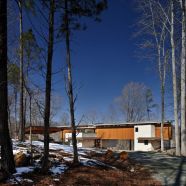
Cassilhaus. Design by Ellen Cassilly Architects. Owners Ellen Cassilly and Frank Konhaus live in the structure on the left and the small apartment on the right houses the artist in residence program. The connecting bridge is home to the exhibition program. Photo by James West of J. West Productions.
Share This
Print This
Email This
Cassilhaus. Where Art and Community Meet
“No, we don’t have kids—we have artists.” That is our standard quip when asked if we have children. We got together as a couple in our mid-forties and in 2006, very early in our partnership, we birthed an extraordinary public art project in downtown Durham, North Carolina, called Warehouse Interventions. We were both downtown business owners with a love of the arts who were desperate for something—ANYTHING—that might jump-start our stagnant downtown.
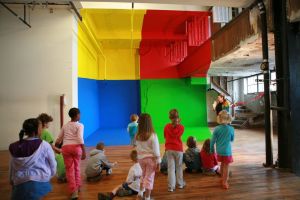
Durham educator Juliet Jensen introduces a school group to the Rousse installation in the former Baldwin Department store.
We brought Paris-based artist Georges Rousse to a moribund city center with modest aspirations to breathe some life into our cultural community. We were completely unprepared for the prairie fire of creative energy and community excitement that ensued. Hundreds of volunteers appeared out of nowhere, thousands of visitors flocked to a deserted downtown, a documentary film was made about the project that went to fifteen film festivals worldwide, and more than twenty major press stories filled Triangle media. It was the ultimate right place/right time event and our community was ready beyond our wildest dreams to participate in a community art happening. If a single artist coming to Durham for a month could have this kind of impact, we knew we had to find a way to keep doing this.
The Rousse project was the midwife for Cassilhaus (a contraction of Ellen Cassilly and Frank Konhaus), our home and community arts nexus in the forest in Orange County, North Carolina. Ellen is an architect and Frank a retired AV system designer and versatile creative. Together they designed and refined the home over three years and moved in in late 2008.
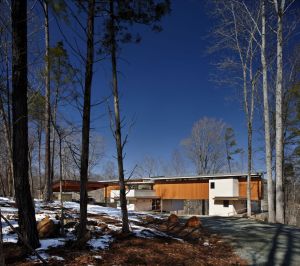
Cassilhaus. Design by Ellen Cassilly Architects. Owners Ellen Cassilly and Frank Konhaus live in the structure on the left and the small apartment on the right houses the artist in residence program. The connecting bridge is home to the exhibition program. Photo by James West of J. West Productions.
Cassilhaus was what the British call purpose built and the design was highly program driven. Perched at the edge of 1600 acres of the Duke Forest, the home celebrates asymmetry as it deploys three trapezoidal volumes across the hillside. Two living “pods”—a main house for us and a self-contained guest house/studio programmed for our artist residency. They are joined by a long bridging structure housing an art gallery that hosts our exhibitions.
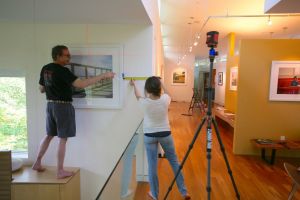
Frank Konhaus (left) and Cassilhaus MFA intern Michaela O’Brien install work during the installation of a new exhibition.
We often think of it as a stool. The four legs are the architecture itself, a diverse exhibition program, a multidisciplinary artist residency, and a significant photography-centric contemporary art collection. The seat of the stool is the community, which has flourished and grown organically over fourteen years—fifty-four visiting artists, forty-five exhibitions (including four MFA thesis shows), over 600 works of art in the Cassilhaus Collection, and thousands of community members who have intermingled, engaged, and made magic in ways we never could have imagined. We’ve even had two couples meet at Cassilhaus and get married.
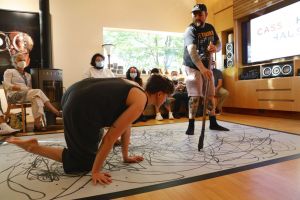
Cassilhaus Artist in Residence John Felix Arnold (right) collaborates on a performance piece with Leo Ryan of the Duke University dance MFA program.
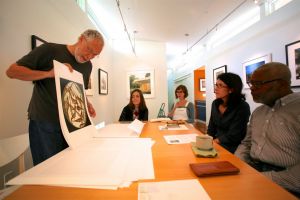
Durham artist Jim Lee (far left) presents his work during a portfolio review with Cassilhaus Artists in Residence Hannah Frieser and Charles Guice (right) while Cassilhaus MFA interns Michaela O’Brien and Alyssa Misserendino look on.
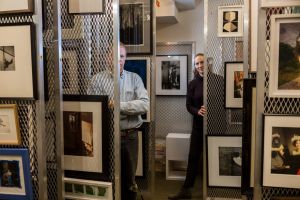
Portrait of Ellen and Frank in the art storage room of the Cassilhaus Collection. Photo by Jerry Siegel.
***
An artist often has an idea. They want to achieve something but do not have all of the tools to manifest their vision. At Cassilhaus, we invite artists to explore and to stretch beyond their comfort zone, often with the help of human and physical resources in our community.
Photographer and resident artist Chris McCaw is our poster child for how amazing these artist/community interactions can be. Chris travels the globe photographing the arc of the sun using large military reconnaissance lenses mounted onto Cirkut camera bodies.
Chris had a very specific idea of what he wanted to accomplish artistically and mechanically yet he was quickly stepping outside of his area of expertise.
We needed to team Chris up with folks who understood optics, mechanics, coding, geolocation, and astronomy. Enter Frank “the connector” who found Dr. Chris Clemens, the then chair of the physics and astronomy department at the University of North Carolina at Chapel Hill. Clemens’s endearing response to Frank’s cold call email was, “what Chris proposes is likely impossible. When do we get started?”
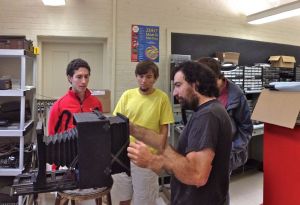
Cassilhaus Artist in Residence Chris McCaw works with UNC Students in Dr. Clemens class to develop his prototype camera.
Each year Dr. Clemens creates a special projects’ class for his summer independent studies students, and he assembled a for-credit class for two PhD, two masters, two undergraduate, and a high school student to build McCaw’s camera. Chris’s highest hope was to come to Cassilhaus to find mentors to advise him and instead he arrived to a fully working prototype of his camera, and the team spent the following month refining it. At the end of his residency, Chris gave an artist’s talk to a packed house at the Nasher Museum of Art at Duke University with his student scientist partners in the front row. Many of these students had no previous connection with art and had rarely entered an art museum. All parties were indelibly transformed by the experience.
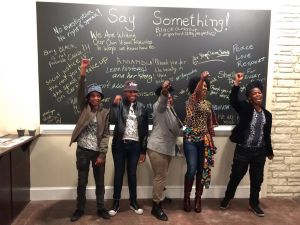
Cassilhaus Artist in Residence Zanele Muholi (right) and collaborators (from left) Lerato Dumse, Thembela Dick, Lindeke Qampi, and visiting artist Sheila Pree Bright at opening for Sheila’s exhibition as part of a collaboration with Cassilhaus and the Click! Photography Festival.
Another spectacular example of what is possible with our resident artist collaborations was with South African visual activist Zanele Muholi. Muholi travels extensively, often with a cohort of LGBTQIA+ hate-crime survivors who they mentor and train in documentary methods. Frank engaged six local art and LGBTQIA+ groups so that Muholi and their team could have maximum impact in our community. During their residency, they presented to school groups, met with the local documentarians of color, gave an artist’s talk at the North Carolina Museum of Art, and even organized an extremely ambitious pop-up exhibition on an insane timeline for the annual Click! Photography Festival. Zanele created five iconic photographs at Cassilhaus during their stay and all editions have sold out.
The Cassilhaus Exhibition Program grew out of the natural impulse to share work collected through decades of discovery and love of art and artists. It has evolved into a sophisticated series of curated experiences to showcase contemporary work in all media. Our personal collection is as much a collection of stories as it is of artworks. About every fourth exhibition in the gallery is drawn entirely from our collection and thematically curated. Recent exhibitions from the collection include Beyond the Horizon, Thinly Veiled, Picture in Picture, and Visage: Face with a View.
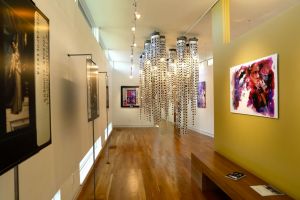
Installation view from the Diapositive exhibition at Cassilhaus. Curated by Lisa McCarty and Frank Konhaus. Featured artists include Lucinda Bunnen, Amy Herman, Eric Pickersgill, Ian Trask, Vesna Pavlović, and Jean Shin.
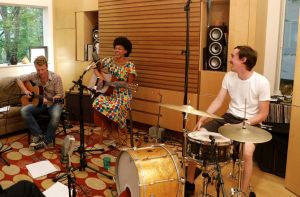
Durham singer songwriter Kamara Thomas performs as part of the programming for the Ekphrasis exhibition at Cassilhaus.
Students study concepts of art and design in the classroom but rarely do they get beyond the PowerPoint presentations. At Cassilhaus they can walk through thoughtful, intentional spaces, engage directly with artists and their work, hold an actual print in their hands, and have an emotional connection and experience with art and architecture that they may never have had before. The immediacy and intimacy with the art and the surroundings cannot be overstated. It has a powerful effect to invite the viewer to look and engage deeply and more slowly.
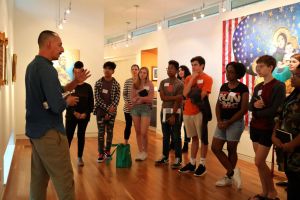
Cassilhaus Visiting Artist Gabriel Garcia Roman (far left) mentors students from the Nasher Museum Teen Council during the En|Gender exhibition at Cassilhaus Gallery.
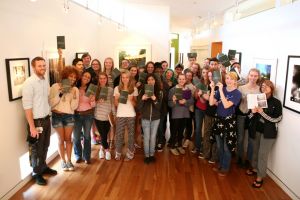
Durham Public School educator Jonathan Twietmeyer (far left) brings his Introduction to Darkroom Photography class to tour the Tracing the American South: Photographs from the Do Good Fund exhibition. Curated by Tom Rankin and Rachel Boillot.
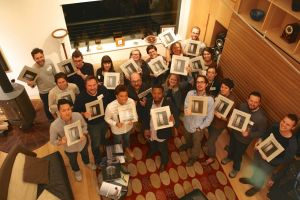
Combined MFA classes from Duke University and The University of North Carolina at Chapel Hill during the Faraway Nearby Exhibition featuring work from six faculty from the two programs. Exhibition curated by Huston Paschal and Lisa McCarty. Each student was gifted a monograph of the work of photographer John Menapace.
The same holds for our larger community. After a recent visit by Nancy Goodwin of Montrose Gardens in Hillsborough, North Carolina, she effused in an email:
Good morning. I can’t get over it! I felt as if I were in another world, not of this world—one with an understanding of the land as well as the fundamentals of living. When we approached the house, I gasped at the view toward the other side, which immediately became a miracle. No other houses, no other people, and only a “wild” forest and an unsolvable mystery in the clouds rising from the little river.
But that was just the beginning. We came to see Elizabeth Matheson’s spectacular, introspective, and sometimes amusing art. I went quickly through the show and then slowly. Somehow it told her story with sensitivity to the subjects and always with something special not seen at a glance but discovered as I looked again slowly.
You opened my eyes to each tiny detail, and I hope it will make me go slower and look longer as I live in this place.
Along this journey we have collaborated with and developed alliances with local arts and architecture organizations, nonprofits, art faculty, school groups of all levels from elementary school to post-graduate, museum groups, visual artists, choreographers, filmmakers, dancers, poets, curators, writers, performers, camera clubs, and stragglers.
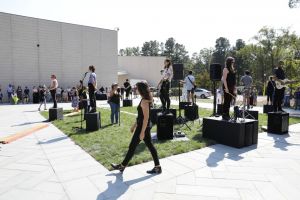
Cassilhaus Artist in Residence Naama Tsabar (center) creates an aurally and visually immersive performance featuring 21 local musicians who identify as women and/or gender nonconforming at the Nasher Museum of Art at Duke University.
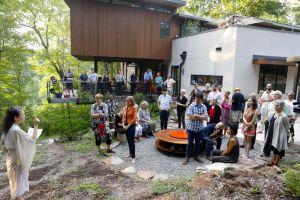
Cassilhaus Artist in Residence Eiko Otake speaks after a performance staged in and around Cassilhaus in collaboration with the American Dance Festival.
We knew from the outset that having artists in our home would be a rich experience but we never could have imagined how it would transform our lives and enhance our appreciation of their work. Artists come as visitors and leave as friends—some quite close friends for more than a decade now. We have traveled the world to stay with past residents to deepen these connections and follow their artistic paths. We have hosted five- and ten-year artist-in-residence reunions and they have been two of the most fun long weekends in our lives. A fifteenth reunion is scheduled for 2024. Because artists are only here one at a time, the reunion is an amazing opportunity for them to come together, meet, and celebrate this shared experience—some artists have even planted the seeds for future collaborations. Our wonderful community houses all of them and the hosts get to join in the fun.
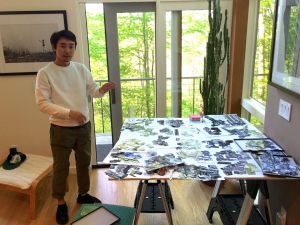
Artist in Residence Sohei Nishino in production on a massive photo collage using over 3500 individual photographs of Duke Forest and New Hope Creek.
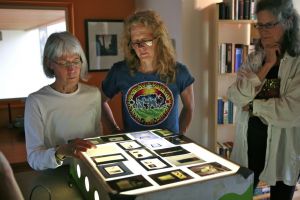
Artist in Residence Marie Navarre teaching a large format negative workshop for regional photographers.
We are a bit organization-phobic. We are not a nonprofit. We don’t have a board. We have no public hours. There is no application process for the residency or exhibition program. All proceeds from art sales go directly to the artist. We wear a lot of hats—host, gallerist, mentor, publisher, collector, curator, designer, educator, student, maintenance guy, and parents to resident Cassilhaus felines Jaco and Joni. It’s the Frank and Ellen show but not in a dogmatic way. We like simplicity and directness. We are open to all possibilities and have an ocean of wonderful collaborators and mentors. We like to have an idea, meet a new artist, see new work, and make something happen without a committee or years of planning.
We run Cassilhaus on a tiny budget mostly provided by Airbnb rentals, community goodwill, and old-fashioned ingenuity. Frank works full-time pro bono and we have a small part-time paid staff, which includes an MFA intern each year. We frame most of our exhibitions in-house. Patch and paint our own walls. Hang and light the work. Produce our gallery guides and develop our own programming. It’s insane that it all works but the universe continues to drop amazing opportunities into our orbit at opportune times and we somehow manage to keep the train on the tracks.
At the end of the day, however, Cassilhaus is our home. Over the years we have certainly fallen on either side of a perfect balance between enough and too much and this evolves constantly. We will keep doing it as long as it is fun and engaging. Happily, we continue to get more back than we give. It is the ultimate labor of love.
**All photographs by Frank Konhaus except where noted.







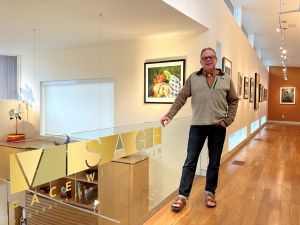
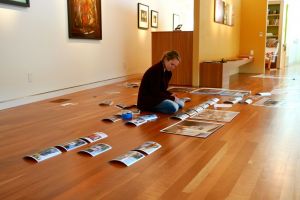
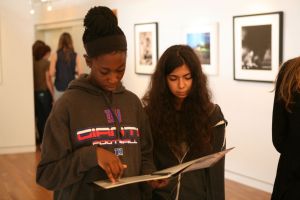
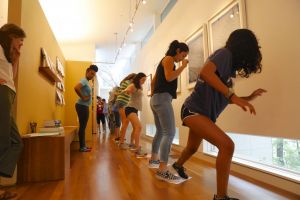
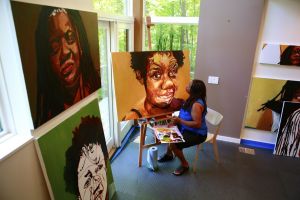
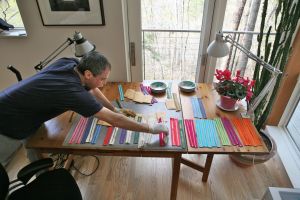
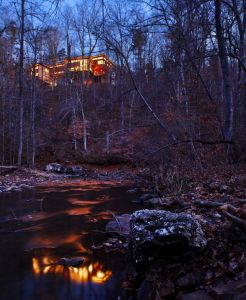
I can say many good things about Ellen Cassily as an architect, since she help me with a modest work, (to bring light to an old house and allowedme to enjoy it better for 20 or so more years)….That was then…..I discover the Cassilhaus were the same brand of quality and intentionality seems to be at work … My warmest congratulations!!…
Thank you for your kind words. i hope that you are well.